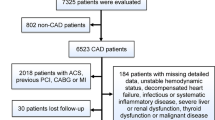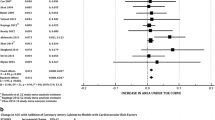Abstract
Much controversy surrounds the use of high-sensitivity C-reactive protein (hs-CRP) as a marker of cardiovascular (CV) risk. Although data regarding the association of hs-CRP with CV disease is extensive and consistent, its role in clinical practice remains unclear. The American Heart Association (AHA) recently published a scientific statement regarding criteria for evaluation of novel markers of CV risk. This article provides a comprehensive review of data regarding hs-CRP as a risk marker for CV disease in the context of these AHA criteria. The impact of the JUPITER trial on the utility of hs-CRP as a risk marker is emphasized. The review concludes with an evidence-based statement regarding the current role of hs-CRP in CV risk prediction.
Similar content being viewed by others
References
Papers of particular interest, published recently, have been highlighted as: • Of importance •• Of major importance
Berk B, Weintraub W, Alexander R. Elevation of C-reactive protein in active coronary artery disease. Am J Cardiol. 1990;65(3):168–72.
Liuzzo G, Biasucci L, Gallimore J, Grillo R, Rebuzzi A, Pepys M, et al. The prognostic value of C-reactive protein and serum amyloid A protein in severe unstable angina. N Engl J Med. 1994;331(7):417.
Cook NR, Buring JE, Ridker PM. The effect of including C-reactive protein in cardiovascular risk prediction models for women. Ann Intern Med. 2006;145(1):21.
Ridker PM. C-reactive protein and the prediction of cardiovascular events among those at intermediate risk: moving an inflammatory hypothesis toward consensus. J Am Coll Cardiol. 2007;49(21):2129–38.
•• Ridker PM, Danielson E, Fonseca FAH, Genest J, Gotto Jr AM, Kastelein JJP, et al. Rosuvastatin to prevent vascular events in men and women with elevated C-reactive protein. N Engl J Med. 2008;359(21):2195. This is the main article of the JUPITER study. It showed the rosuvastatin therapy in those “apparently” healthy population with elevated hs-CRP of >2 mg/L and low LDL (<130 mg/dL) had decreased cardiovascular risk with the use of rosuvastatin.
Hlatky MA, Greenland P, Arnett DK, Ballantyne CM, Criqui MH, Elkind MSV, et al. Criteria for evaluation of novel markers of cardiovascular risk: a scientific statement from the American Heart Association. Circulation. 2009;119(17):2408.
• Bajpai A, Goyal A, Sperling L. Should we measure C-reactive protein on Earth or just on JUPITER? Clin Cardiol. 2010;33(4):190–8. This article provides a comprehensive review of the data regarding cardiovascular risk and hs-CRP with an emphasis on the JUPITER trial .It concludes with an evidence-based analysis of the role of hs-CRP in cardiovascular risk assessment.
Hirschfield G, Pepys M. C-reactive protein and cardiovascular disease: new insights from an old molecule. QJM. 2003;96(11):793.
Kushner I. C-reactive protein and the acute-phase response. Hosp Pract (Off ed). 1990;25(3):13.
Gabay C, Kushner I. Acute-phase proteins and other systemic responses to inflammation. N Engl J Med. 1999;340(6):448.
Vigushin D, Pepys M, Hawkins P. Metabolic and scintigraphic studies of radioiodinated human C-reactive protein in health and disease. J Clin Investig. 1993;91:1351–1.
De Beer F, Soutar A, Baltz M, Trayner I, Feinstein A, Pepys M. Low density lipoprotein and very low density lipoprotein are selectively bound by aggregated C-reactive protein. J Exp Med. 1982;156(1):230.
Pepys M, Rowe I, Baltz M. C-reactive protein: binding to lipids and lipoproteins. Int Rev Exp Pathol. 1985;27:83.
Chang M, Binder C, Torzewski M, Witztum J. C-reactive protein binds to both oxidized LDL and apoptotic cells through recognition of a common ligand: phosphorylcholine of oxidized phospholipids. Proc Natl Acad Sci USA. 2002;99(20):13043.
Vigo C. Effect of C-reactive protein on platelet-activating factor-induced platelet aggregation and membrane stabilization. J Biol Chem. 1985;260(6):3418.
Volanakis J, Narkates A. Binding of human C4 to C-reactive protein-pneumococcal C-polysaccharide complexes during activation of the classical complement pathway. Mol Immunol. 1983;20(11):1201–7.
Zhang Y, Cliff W, Schoefl G, Higgins G. Coronary C-reactive protein distribution: its relation to development of atherosclerosis. Atherosclerosis. 1999;145(2):375–9.
Nordestgaard BG, Zacho J. Lipids, atherosclerosis and CVD risk: Is CRP an innocent bystander? Nutr Metab Cardiovasc Dis. 2009;19(8):521–4.
Casas J, Shah T, Hingorani A, Danesh J, Pepys M. C-reactive protein and coronary heart disease: a critical review. J Intern Med. 2008;264(4):295–314.
•• Zacho J, Tybjaerg-Hansen A, Jensen JS, Grande P, Sillesen H, Nordestgaard BG. Genetically elevated C-reactive protein and ischemic vascular disease. N Engl J Med. 2008;359(18):1897. This landmark genetic study showed that polymorphisms in the CRP gene are associated with marked increases in CRP levels but with no increase risk of ischemic vascular disease.
Danesh J, Wheeler JG, Hirschfield GM, Eda S, Eiriksdottir G, Rumley A, et al. C-reactive protein and other circulating markers of inflammation in the prediction of coronary heart disease. N Engl J Med. 2004;350(14):1387.
Buckley DI, Fu R, Freeman M, Rogers K, Helfand M. C-reactive protein as a risk factor for coronary heart disease: a systematic review and meta-analyses for the US Preventive Services Task Force. Ann Intern Med. 2009;151(7):483.
Kaptoge S, Di Angelantonio E, Lowe G, Pepys MB, Thompson SG, Collins R. Emerging Risk Factors Collaboration. C-reactive protein concentration and risk of coronary heart disease, stroke, and mortality: an individual participant meta-analysis. Lancet. 2010;375:132–40.
May M, Lawlor D, Brindle P, Patel R, Ebrahim S. Cardiovascular disease risk assessment in older women: can we improve on Framingham? British Women’s Heart and Health prospective cohort study. Br Med J. 2006;92(10):1396.
Cook NR. Use and misuse of the receiver operating characteristic curve in risk prediction. Circulation. 2007;115(7):928.
Cao J, Arnold A, Manolio T, Polak J, Psaty B, Hirsch C, et al. Association of carotid artery intima-media thickness, plaques, and C-reactive protein with future cardiovascular disease and all-cause mortality: the Cardiovascular Health Study. Circulation. 2007;116(1):32.
Sattar N, Murray H, McConnachie A, Blauw G, Bollen E, Buckley B, et al. C-reactive protein and prediction of coronary heart disease and global vascular events in the Prospective Study of Pravastatin in the Elderly at Risk (PROSPER). Circulation. 2007;115(8):981.
Shlipak M, Fried L, Cushman M, Manolio T, Peterson D, Stehman-Breen C, et al. Cardiovascular mortality risk in chronic kidney disease: comparison of traditional and novel risk factors. JAMA. 2005;293(14):1737.
Wilson PWF, Nam BH, Pencina M, D’Agostino Sr RB, Benjamin EJ, O’Donnell CJ. C-reactive protein and risk of cardiovascular disease in men and women from the Framingham Heart Study. Arch Intern Med. 2005;165(21):2473.
Rutter M, Meigs J, Sullivan L, Sr D’Agostino R, Wilson P. C-reactive protein, the metabolic syndrome, and prediction of cardiovascular events in the Framingham Offspring Study. Circulation. 2004;110(4):380.
Koenig W, Lowel H, Baumert J, Meisinger C. C-reactive protein modulates risk prediction based on the Framingham Score: implications for future risk assessment: results from a large cohort study in southern Germany. Circulation. 2004;109(11):1349.
Janes H, Pepe M, Gu W. Assessing the value of risk predictions by using risk stratification tables. Ann Intern Med. 2008;149(10):751.
•• Pencina MJ, D’Agostino Sr RB, Jr D’Agostino RB, Vasan RS. Evaluating the added predictive ability of a new marker: from area under the ROC curve to reclassification and beyond. Stat Med. 2008;27(2):157–72. This article intoduces the Net Reclassification Index (NRI) as a novel way of measuring the additive effect of a variable to a model in reclassifying individuals to different risk category.
Hosmer D, Lemesbow S. Goodness of fit tests for the multiple logistic regression model. Commun Stat-Theory Methods. 1980;9(10):1043–69.
Wilson P, Pencina M, Jacques P, Selhub J, Sr D’Agostino R, O’Donnell C. C-reactive protein and reclassification of cardiovascular risk in the Framingham Heart Study. Circ Cardiovasc Qual Outcomes. 2008;1(2):92.
Cook N. Comments on ‘Evaluating the added predictive ability of a new marker: From area under the ROC curve to reclassification and beyond’ by MJ Pencina et al., Statistics in Medicine (DOI. Stat Med. 2008;27(2):191–5.
Shah T, Casas JP, Cooper JA, Tzoulaki I, Sofat R, McCormack V, et al. Critical appraisal of CRP measurement for the prediction of coronary heart disease events: new data and systematic review of 31 prospective cohorts. Int J Epidemiol. 2009;38:217–31.
McMurray J, Kjekshus J, Gullestad L, Dunselman P, Hjalmarson A, Wedel H, et al. Effects of statin therapy according to plasma high-sensitivity C-reactive protein concentration in the Controlled Rosuvastatin Multinational Trial in Heart Failure (CORONA): a retrospective analysis. Circulation. 2009;120(22):2188.
Ridker PM, Rifai N, Clearfield M, Downs JR, Weis SE, Miles JS, et al. Measurement of C-reactive protein for the targeting of statin therapy in the primary prevention of acute coronary events. N Engl J Med. 2001;344(26):1959.
Spatz ES, Canavan ME, Desai MM. From here to JUPITER: identifying new patients for statin therapy using data from the 1999–2004 National Health and Nutrition Examination Survey. Circ Cardiovasc Qual Outcomes. 2009;2(1):41.
Lee K, Cipriano L, Owens D, Go A, Hlatky M. Cost-Effectiveness of Using High-Sensitivity C-Reactive Protein to Identify Intermediate-and Low-Cardiovascular-Risk Individuals for Statin Therapy. Circulation. 2010;122:1478–87.
Slejko JF, Page 2nd RL, Sullivan PW. Cost-effectiveness of statin therapy for vascular event prevention in adults with elevated C-reactive protein: implications of JUPITER. Curr Med Res Opin. 2010;26(10):2485–97.
Mihaylova B, Briggs A, Hlatky M, Armitage J, Parish S, Gray A, et al. Statin cost-effectiveness in the United States for people at different vascular risk levels. Circ Cardiovasc Qual Outcomes. 2009;2(2):65–72.
Pletcher M, Lazar L, Bibbins-Domingo K, Moran A, Rodondi N, Coxson P, et al. Comparing impact and cost-effectiveness of primary prevention strategies for lipid-lowering. Ann Intern Med. 2009;150(4):243.
Hayward R, Krumholz H, Zulman D, Timbie J, Vijan S. Optimizing statin treatment for primary prevention of coronary artery disease. Ann Intern Med. 2010;152(2):69.
•• Kappagoda CT, Amsterdam EA. Another look at the results of the JUPITER trial. Am J Cardiol. 2009;104(11):1603–5. This articles analyzes the methodology and results of the JUPITER study. It shows significant epidemiologic and methodologic inconsistencies in the JUPITER study that warrant consideration. The article emphasizes that the study population was not a healthy population and that standard medical care was not provided to the population that could have changed the result of the study significantly.
Gibbons R, Fugh-Berman A, Chan P, Nallamothu B, Hayward R, Jenny-Avital E, et al. Rosuvastatin in patients with elevated C-reactive protein. N Engl J Med. 2009;360(10):1038.
• Sattar N, Preiss D, Murray H, Welsh P, Buckley B, de Craen A, Seshasai S, McMurray J, Freeman D, Jukema J. Statins and risk of incident diabetes: a collaborative meta-analysis of randomised statin trials. Lancet 2010. This study is a meta-analysis of the risk of diabetes mellitus with statin therapy. It concludes that statin therapy is associated with a slightly increased risk of development of diabetes, but the risk is low.
Disclosure
The authors report no potential conflicts of interest relevant to this article.
Dr. Antonio Gotto, Editor-in-Chief of Current Atherosclerosis Reports, reviewed this article and provided comments and suggestions. He was a member of the JUPITER Steering Committee, for which he received honoraria, and has served as a consultant for AstraZeneca. He has no financial relationship with the manufacturer of the hs-CRP test.
Author information
Authors and Affiliations
Corresponding author
Rights and permissions
About this article
Cite this article
Abd, T.T., Eapen, D.J., Bajpai, A. et al. The Role of C-Reactive Protein as a Risk Predictor of Coronary Atherosclerosis: Implications from the JUPITER Trial. Curr Atheroscler Rep 13, 154–161 (2011). https://doi.org/10.1007/s11883-011-0164-5
Published:
Issue Date:
DOI: https://doi.org/10.1007/s11883-011-0164-5




